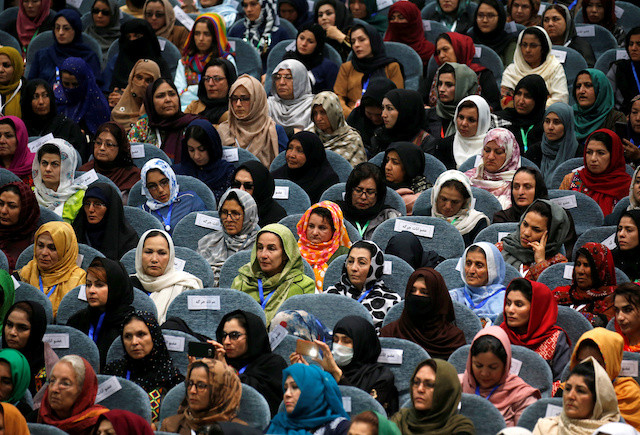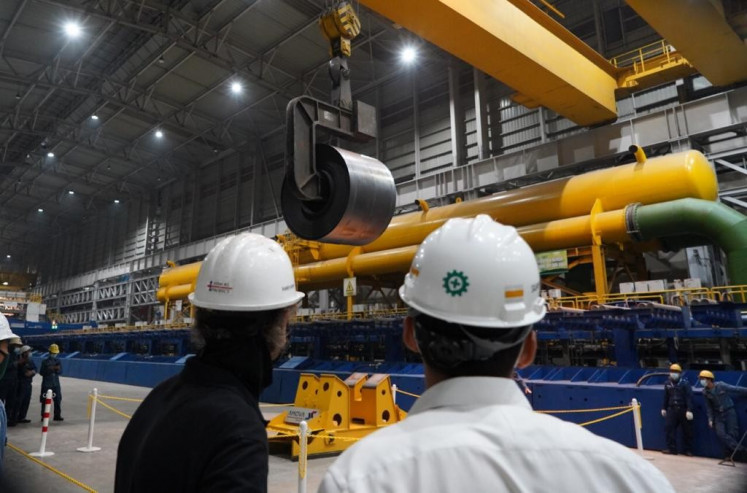Popular Reads
Top Results
Can't find what you're looking for?
View all search resultsPopular Reads
Top Results
Can't find what you're looking for?
View all search resultsWhy we need more women mediators
In many cases, while women are disproportionately affected by conflicts, they play a central role in rebuilding communities and crossing boundaries to demand peace and save lives on the ground.
Change text size
Gift Premium Articles
to Anyone
I
t was a balmy day in November 2020 as I was sitting on a crowded train, my mouth full of bread and hot steamy chai as I struggled to take a sip. I took a glance at the people who picked me up and would bring me to meet the commander.
I was in one of the conflict areas in South Asia. The journey continued over a nine-hour car ride on a muddy road. I wondered what kind of people I would meet, what they would think of me and how should I start the conversation.
In a male-dominated realm of guns and grief, I always make an effort to be a good listener, to be able to understand better. It was one of the series of lengthy journeys I had come across in my work.
Throughout the years, I met and talked to various non-state armed groups and state leaders from regions torn by war across the world for a mission of mediating conflict and bringing the warring parties to the negotiating table. I witnessed resentment, resistance and power at play, but I also saw hope, dignity and dreams of the laypeople for a better, violence-free life.
Official peace processes and final conflict settlement are often said to include women. In many cases, while women are disproportionately affected by conflicts, they play a central role in rebuilding communities and crossing boundaries to demand peace and save lives on the ground.
At the top level, negotiation processes are usually dominated by a masculine paradigm, which concerns only the top official leaders who are mainly men. As a matter of fact, between 1992 and 2019, women only constituted 13 percent of negotiators and 6 percent of mediators in major peace processes worldwide, while seven in 10 peace processes exclude women mediators (UN Women report “Facts and figures: Women, peace and security”, 2020).
Such exclusion might deprive women of the precious opportunity to use their experience and agency to create peace. However, acknowledging that women are mostly portrayed as victims, we must be aware of avoiding a common pitfall by including them in the mediation process merely as a token of pity. Instead, women peacebuilders and mediators have the right to reclaim recognition and representation.
While the terms “peacebuilder” and “mediator” may have interchangeable meanings and manifestation, in practice, mediation demands more specialized skills and formal recognition. It requires years of gaining trust, negotiation capacity, strategic mindset and knowledge of the international mechanism and know-how on standing with impartiality between the warring parties yet remaining both firm and being an empathic listener.
On Dec. 23, 2020, the Southeast Asian Network of Women Peace Negotiators and Mediators (SEANWPNM) was launched during an introductory meeting between members of its steering committee and Indonesian Foreign Minister Retno Marsudi. We should applaud this perspective in the region.
Initiated by Indonesia under the leadership and guidance of the foreign minister, SEANWPNM aims to enable women from the region to advance the inclusion and meaningful participation of women in all phases of peace processes as mediators and negotiators. This will be done by developing the profile, reach and visibility of its members, as well as other women in Southeast Asia interested in conflict resolution to be accepted as a viable “go to” option in mediation.
The SEANWPNM will complement existing initiatives in ASEAN and the region that seek to advance the inclusion and meaningful participation of women in all phases of peace processes as mediators and negotiators. Equally important is to go beyond a symbolic network of women, and to put efforts in engaging more women as mediators. Nourishing a women mediators’ network in the region and globally should complement this need.
The COVID-19 pandemic has taught us that we are now living in a polarized world – but not in the old sense like the West versus the East or the global North versus the global South. Rather, it is now a global geopolitical shift where even the most advanced countries we look up to are now in social, economic and political turmoil. Across the world, women rise up as active interlocutors representing their communities and countries to address this challenge.
In the face of conflict and turmoil, we need to create a more inclusive, holistic and sustainable process that facilitates lasting peace based on development, social cohesion and reconciliation. Women mediators have demonstrated their expertise and carried out their formal mandate.
The inclusion of the diverse women and recognition of their intersectionality – representing diverse ethnicities, races, classes, castes, religions and citizenship statuses – in peace mediation would imply their unique contribution based on their particular experience while simultaneously mainstreaming women into formal mediation process. This provides an importance for women mediators to create a collective force.
In the complexity of today’s world, mediation needs to deal with multiple crises. Networking shall produce a transnational, collaborative hard work for a long-term result. Peace agreement is not only about ending violence. It is about shaping a vision to rebuild the political economy infrastructure of the war-torn area, help improve the government through democratic political participation and economic recovery, acknowledgment of the human rights issues and gender justice, among other things.
Nevertheless, there is also a deeper meaning to mediation. It is to reveal how conflict and peace share a similar human face: fear, anger, hope and social belonging. When we can sit down with those who have taken up arms to fight to talk about peace, we can grasp the significance that the mediation outcomes would affect maybe millions of people’s lives in the region.
That is where we know that we carry the message of humanity, and women have come a long way to be exactly an active part of this.
***
The writer is an international mediator and steering committee member of the Southeast Asian Network of Women Peace Negotiators and Mediators (SEANWPNM). The views expressed are her own.










